They faced off, each mountain of a man sizing the other up in a display that was as much bravado & wit as it was skill. The aim was obvious to even one who’d never seen this spectacle before, the psyche out. They retreated to their respective corners and threw salt with a certain nonchalance, purifying themselves with water and then heading back to the centre of the circle. They lifted and stamped each foot, trying to fall into rhythm with each other.
The Sumo Wrestling Tokyo Grand Tournament is pretty special.
There’s more to it than big guys throwing each other out of a ring.
I’ve wanted to see a sumo match since I was a kid – after watch 3 Ninjas Kick Back for the hundredth time. If you’ve never seen this B-grade 90’s classic, let me break it down for you quickly. Three brothers – trained in the ways of the ninja by their Japanese grandfather – follow him to Japan after an accidental bag swap, and get caught up in a plot involving an ancient dagger, legendary cave of gold, and – wait for it – the bad guy. Bet you didn’t see that coming…
This movie was the first time I saw Japan on TV if you don’t count Sailor Moon and I was fascinated. It made me want to visit Japan one day and watch sumo wrestling. I made this reality when I went to the 2017 Sumo Wrestling Grand Tournament in September, on the second last day of the entire tournament.
So, How Does a Sumo Match Work?
To win a sumo bout, a wrestler has to either;
- Force his opponent out of the ring.
- Make any part of his opponent’s body – other than the soles of his feet – touch the ground.
There are 82 winning moves that are recognised, though only a fraction of those are ever used. The winning sumo takes half the prize money, and the rest goes to the Japan Sumo Association. Prize money comes from companies who sponsor the bout, every 60,000 yen is represented by a flag and these are walked around the ring before the bout begins.
When and Where to Watch Sumo Wrestling
There are six tournaments held per year. One each in Osaka, Nagoya and Fukuoka, and three in Tokyo. They last 15 days.
- Tokyo – JANURARY
- Osaka – MARCH
- Tokyo – MAY
- Nagoya – JULY
- Tokyo – SEPTEMBER
- Fukuoka – NOVEMBER
How to Watch Sumo Wrestling in Tokyo
There are two ways to get Sumo Wrestling Grand Tournament tickets;
- Buy them direct through the official website when they release: DIRECT
- Buy them through a third party site, I used tour operator Viator: VIATOR
What if Tickets are Sold Out?
I was arriving in Japan at the end of the September tournament, and there were only one or two days I could go. On ticket release day, the direct tickets sold out almost immediately. This is a common occurrence for the Tokyo Tournament. I thought I’d missed my chance!
But the tour companies? They buy in bulk.
So luckily, after a bit of searching, I found out that Viator still had tickets. It cost more, but was a guided group style tour. This actually came in handy because 1) I didn’t know much about sumo, and 2) I was traveling solo.
The Point?: A trusted third party is your best bet if direct tickets sell out.
Viator only sells tickets to the Tokyo Tournaments, but if you’re interested in the other cities (see below) companies like Voyagin, etc may have a similar offering.
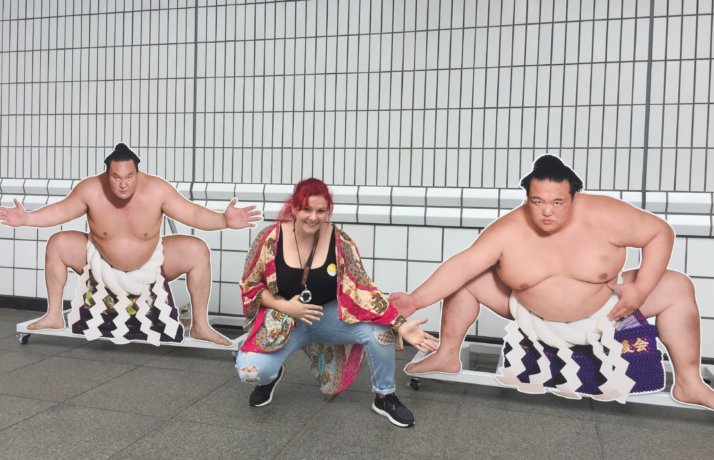
Pros & Cons
Direct – Pros
- Significantly cheaper, a reserved chair seat in Section B will cost around 3,300 yen (just $40 AUD).
- English commentary audio sets are available to rent at the venue.
- Free to arrive at any time, meaning you could spend the entire day there if you wanted.
- You can make your own way to the tournament, which might be more direct depending where in Tokyo you’re staying.
Direct – Cons
- Tickets sell out quickly. You have to wait on the website on release day at the time of release; I missed it by less than a few mins and the tickets I wanted sold out.
- There’s no one to explain what’s happening.
- Not as good for solo travellers, you get more into the atmosphere in a group.
Viator – Pros
- Local English speaking guide. Very knowledgable, able to explain what was happening and what moments to watch out for.
- Visit the Sumo Museum; features a fascinating collection of sumo related historical photographs, art and memorabilia.
- Included train ticket from Hamamatsucho Bus Terminal to Ryogoku Station, with your group and guide.
- Our wonderful guide gave us each a sheet she’d made of that day’s bouts, with the wrestlers names, rank, wins – losses, other stats, and a personal comment; like “from Mongolia, smiley” or “nickname panda”. She’d also highlighted her personal favourites.
- Best option if you’re attending the tournament on your own, as it gives you an opportunity to meet other travellers and experience the atmosphere as a group.
Viator – Cons
- Far more expensive, around $110 AUD (or 9,122 yen) for a chair seat in Section B.
- Meeting your guide and group at Hamamatsucho Bus Terminal to travel could be indirect for you.
- You’ll only arrive at the stadium around 3:30pm, to catch some of the Juryo bouts, before the Makuuchi.
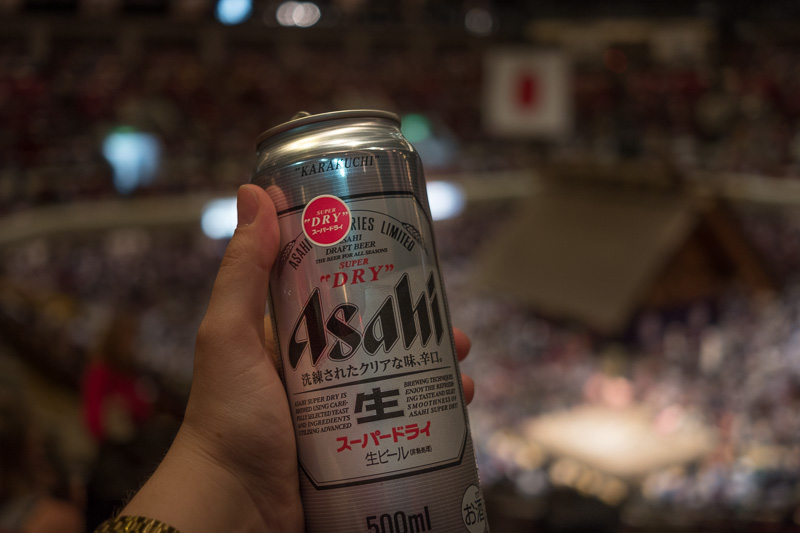
What are the Best Seats for Watching Sumo Wrestling?
There are 2 types of seats, Box Seats and Arena Seats.
Box Seats: A traditional floor seat. Each box has 4 cushions, seating four people. These are on the 1st Floor, and closer to the ring, but more expensive. You can’t buy just part of a box, you must purchase the full four seats/tickets. If you aren’t accustomed to sitting cross legged for a long time, and there’s two of you, you could buy two tickets/seats each, and sit with your legs stretched out in front of you.
Section Distance from Ring (approx):
Box A: 10-24m | Box B: 18-30m | Box C: 25-33m
Arena Seats: Normal seats like in any arena or stadium, with a proper chair style seat. These are on the 2nd Floor, and not as close to the ring. But they are the seats I’d recommend to travellers for their comfort and lower price. The view from my seat in Section “Arena B” was really good, I could see perfectly, the only issue is that you’ll want a zoom lens to get good photos. I was using a 27mm Prime and had to crop in on my photos a lot.
Section Distance from Ring (approx):
Arena A: 22-33m | Arena B: 31-41m | Arena C: 37-45m
How Sumo Wrestling Tournament Day Works
The top two divisions – and main ones to see on tournament day – are:
Makuuchi – senior/first division.
Juryo – junior/second division.
Sumo wrestlers move up or down in the rankings depending on their wins v losses.
The Yokozuna – Grand Champion – is the only Sumo rank that doesn’t get demoted, he’s expected to retire when he can’t perform at peak, or is deemed to not’ve upheld the honour of his rank. This happened back in November
Tournament bouts are played from lowest ranks to highest.
8:30am (or 10:00am from Day 13) – Preliminary bouts, lower ranks.
2:30pm – Juryo entrance, followed by bouts.
3:30pm – Makuuchi entrance, followed by Yokozuna entrance, followed by bouts.
6:00pm – Yumitori-shiki – or Bow Twirling Ceremony
All times approximate only.
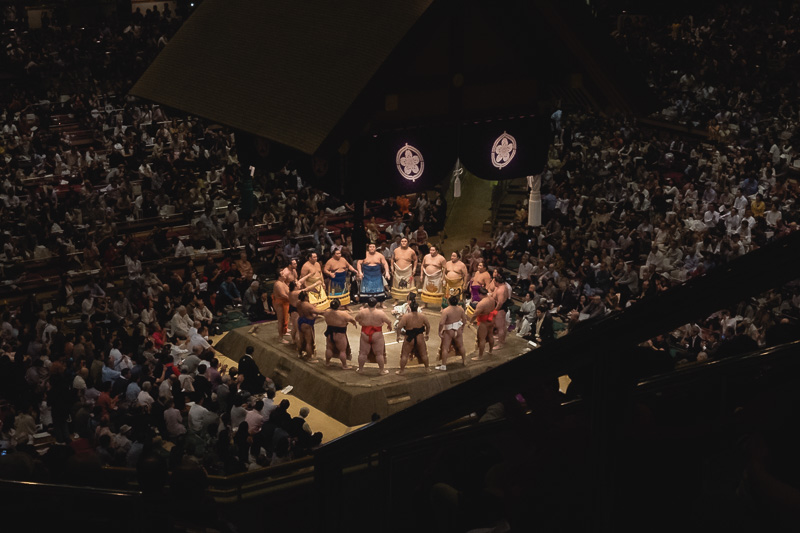
Best Moments to Watch Sumo Wrestling in Tokyo
Be sure to catch these moments during the senior division at the tournament;
- Makuuchi Ceremonial Entrance: Before the Makuuchi divison starts, the wrestlers enter the ring in their kesho-mawashi ceremonial aprons, stand in a circle, and perform a small ceremony.
- Yokozuna Grand Champion Ceremonial Entrance: The others clear and the Yokozuna, wearing a thick ornamental rope with paper strips of paper hanging off it, enters with two ‘attendant’ sumos (one is a sword bearer) and performs his own ceremony.
- Pre-Match Ritual: The start of every bout is spent psyching each other out; the wrestlers walk to the corners of the ring, throw salt, purify themselves with water. Then they face off, lift & stamp each leg, and pretend to start the bout, only to pull back and do it all over again. The crowd works into a frenzy with every return to the sides of the ring. It’s magic.
- Bow Twirling Ceremony: The Yumitori-shiki is performed at the end of every tournament day. Its origins are from the 1700’s; the Shogun is said to have given a wrestler a bow for winning a tournament. When the shogun died, the Yumitori-shiki was created to honour him.
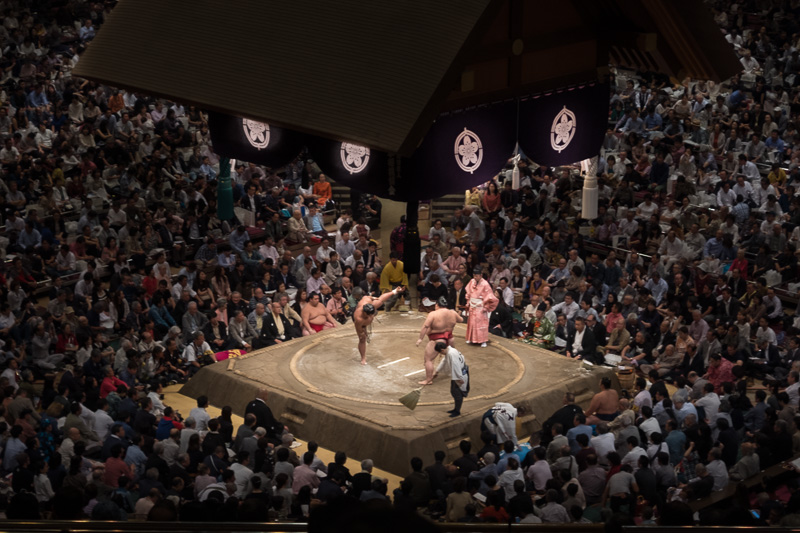
How Sumo Wrestling Started
How old is Sumo? Old af!
Sumo wrestling is believed to have originated around 1500 years ago. Entwined with Shinto ritual, it was performed to honour the spirits and ensure a bountiful harvest.
In the 8th Century it was introduced into ceremonies of the imperial court; a rough-and-tumble, no holds barred event combing boxing and wrestling. With no rules and many deaths.
Eventually rules and techniques were introduced, giving us something closer to the Sumo of today.
During the civil war of the late-Heian Period, Sumo was used by the military to increase the efficiency of their men. Later, in the hands of the Samurai, an offshoot of sumo was developed – Jujitsu.
After peace arrived, Japan enjoyed a period of prosperity, and a professional sumo organisation was organised to entertain the merchant and working classes. Finally turning it into the national sport.
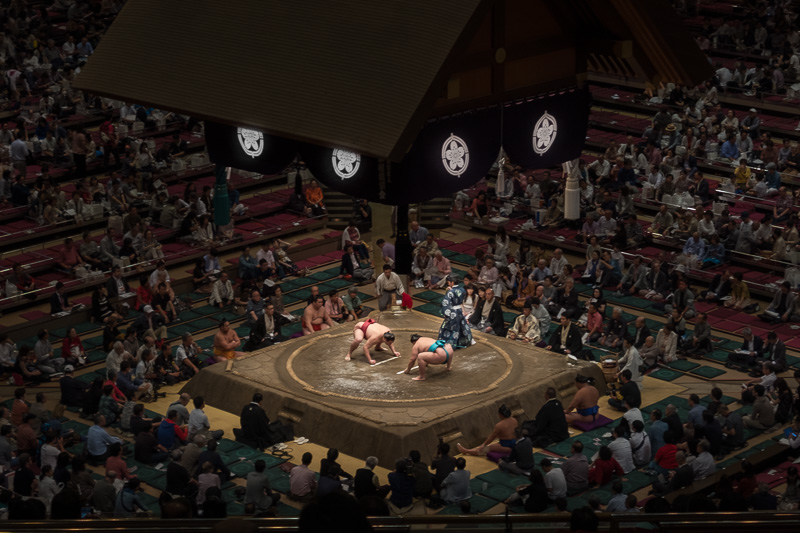
Random Interesting Sumo Wrestling Facts
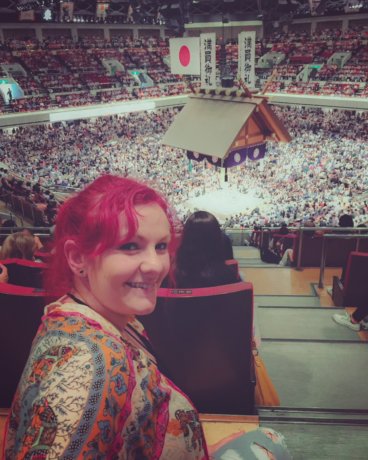
- Actual Sumo bouts last only seconds! Rarely more than a few minutes. Most of a bout is taken up by pre-match ritual, trying to psyche each other out.
- Sumos weren’t behemoths in the old days, they were slimmer and more muscular looking. But because there are no weight classes in Sumo, wrestlers now aim to be as big as possible.
- Sumo wrestlers aren’t allowed to drive, must wear traditional attire in public at all times, and have to grow their hair out to be able to tie into an Edo style topknot.
- They eat Chankonabe – a type of stew – twice a day with rice and beer. This sumo diet staple clocks in at around 10,000 calories per sitting. In fact, their diets, sleep, and training are all strictly regimented.
- Women can’t be Sumo wrestlers, even though there are historical examples of it. They’re actually not allowed to step into the ring, even to save a man’s life
- Loads of Sumos are foreign! Mongolians, Hawaiians, and Eastern Europeans are common in the sport. So much that they introduced a rule saying Sumo Stables are allowed only one foreigner per stable.
- Sumo Wrestling is still closely associated with the Shinto religion, and governed by its principles. They purify the ring with salt, the referee’s robes are similar to that of a Shinto priest, even the canopy over the ring is modelled after a shinto shrine roof.
- And finally, there’s a third way a match can end. If one of the wrestlers loses his mawashi – or loincloth – he is disqualified, with hurt pride and a red face I’d say.
So…I Can Watch Sumo Wrestling in Tokyo?
HELL YES! By the end of this lengthy lovingly written post, I’m sure you’ve worked out that seeing the Sumo Wrestling Tokyo is totally achievable if you’re there on the right dates, even if direct tickets sell out. I could tell you more about the experience of actually being there; the atmosphere, the roar of the crowd as the wrestlers tussled dance-like near the edge of the ring. The spine tingling sensation that occurs when ancient tradition transcends a completely modern world. But really, I can only say go experience it yourself. It’s worth every penny, and if you’re like me, your inner child will thank you.
Be sure to check out my favourite neighbourhood in Tokyo while visiting
SUMO FAQS
How Does Sumo Wrestling Work?
You win by either forcing your opponent out of the ring, or making any part of their body other than their feet touch the ground. 82 winning moves are recognised, with only a fraction ever used. Prize money comes from companies who sponsor the bout.
What do Sumo Wrestlers Eat?
A diet of around 10,000 calories a day! They eat Chankonabe, a protein-rich sumo stew served in huge quantities and eaten twice a day with rice and beer.
When did Sumo Wrestling Start?
About about 1500 years ago as part of a Shinto ritual to honour the spirits. Then used variously throughout time; for imperial death sport, even military training. Finally, Sumo became top entertainment for merchant & working classes in the Edo Period, closer to what it is today.
Does Sumo Wrestling Have Weight Classes?
No it doesn’t, this is why Sumo wrestlers aim to get as big as possible. With the exception of champion Takanoyama Shuntarō. But in historical times, the Sumo was actually slim and more muscular looking.
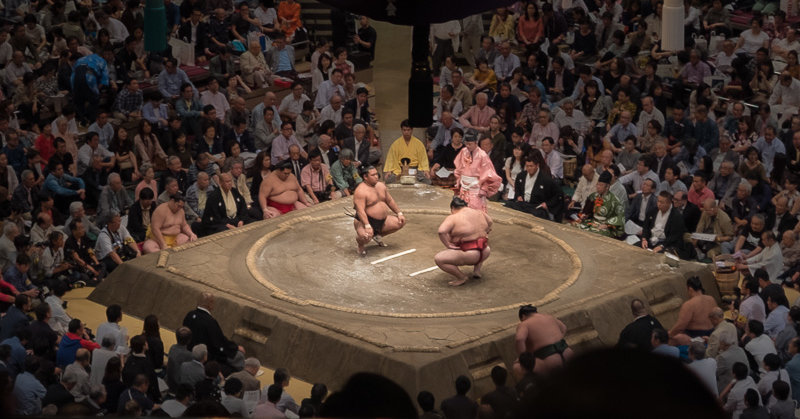

Leave a Reply